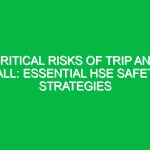Welcome to Today’s Toolbox Talk
Hello everyone! Thank you for gathering here today. As part of our commitment to maintaining a safe and efficient working Environment, we are going to discuss an essential tool that can significantly enhance our Health, Safety, and Environment (HSE) practices — the S.O.R.T Tool. Understanding and utilizing this tool can help us prevent workplace accidents and create a culture of Safety. Let’s dive into what the S.O.R.T Tool is, how it functions, and why it’s vital for our daily operations.
What is the S.O.R.T Tool?
The S.O.R.T Tool stands for Safety Observations, Risk Assessments, and Teamwork. It serves as a structured approach to identifying, assessing, and mitigating risks within our workplace. By incorporating the S.O.R.T Tool into our daily routines, we can ensure that safety remains a priority in every task we undertake. The three components of the S.O.R.T Tool — Safety Observations, Risk Assessments, and Teamwork — provide a comprehensive framework for enhancing our HSE practices.
1. Safety Observations
Safety observations involve actively monitoring work practices and identifying any unsafe conditions or behaviors. This proactive approach helps in recognizing potential Hazards before they lead to incidents. For example, if someone notices that a coworker is not wearing the required Personal Protective Equipment (PPE), they should intervene immediately. The importance of safety observations cannot be overstated; they foster a culture of vigilance and accountability.
Best Practices for Safety Observations
- Be Proactive: Always look for potential Hazards, even if they do not seem immediately dangerous.
- Communicate: Share your observations with your team and encourage them to do the same.
- Document: Keep a record of any unsafe practices or conditions you observe. This helps track trends and implement necessary changes.
2. Risk Assessments
Risk assessments are critical for evaluating the likelihood and severity of identified hazards. This process allows us to prioritize our safety efforts. For instance, if a task involves working at heights, a thorough risk assessment should be conducted to determine the necessary Safety Measures, such as harnesses or guardrails. By assessing risks regularly, we can minimize potential accidents and ensure a safer work environment.
Steps for Conducting Effective Risk Assessments
- Identify Hazards: Look for anything that could potentially cause harm.
- Evaluate Risks: Determine who might be harmed and how, and assess the likelihood of occurrence.
- Implement Control Measures: Decide on the Precautions needed to control the risks.
- Monitor and Review: Continuously check the effectiveness of your measures and make adjustments as necessary.
3. Teamwork
Teamwork is essential for effective safety practices. When team members collaborate and communicate openly about safety concerns, they create a supportive environment where everyone feels responsible for each other’s well-being. This aspect of the S.O.R.T Tool emphasizes that safety is not just an individual responsibility but a collective effort.
Fostering Effective Teamwork
- Encourage Open Communication: Create an atmosphere where team members feel comfortable voicing concerns.
- Hold Regular Safety Meetings: Use these meetings to discuss safety issues, share observations, and brainstorm solutions.
- Recognize Contributions: Acknowledge team members who actively contribute to safety efforts, reinforcing positive behavior.
The Importance of S.O.R.T Tool in HSE
Utilizing the S.O.R.T Tool in our daily operations significantly enhances our HSE practices. By focusing on safety observations, conducting thorough risk assessments, and promoting teamwork, we not only protect ourselves but also our colleagues and the environment. Let’s consider a real-life scenario: Imagine a construction site where workers are using heavy machinery. If one worker observes another not following safety protocols, such as not securing materials properly, they should feel empowered to speak up. This simple act of observation and communication could prevent serious accidents.
Identifying Potential Hazards
While using the S.O.R.T Tool, it’s crucial to identify potential hazards. These may include:
- Physical Hazards: Such as slips, trips, and falls, especially in construction or factory settings.
- Chemical Hazards: Exposure to harmful substances that may cause health issues.
- Ergonomic Hazards: Poor workstation design leading to repetitive strain injuries.
By being aware of these hazards and integrating the S.O.R.T Tool into our workflows, we can take proactive steps to mitigate risks and enhance our overall safety culture.
Regulations and Standards
Compliance with safety Regulations and standards is non-negotiable. The S.O.R.T Tool aligns with various HSE regulations, ensuring we meet our legal obligations. For instance, the Occupational Safety and Health Administration (OSHA) expects employers to provide a safe working environment. By incorporating the S.O.R.T Tool, we demonstrate our commitment to these standards, which not only protects our team but also shields the company from potential legal liabilities.
Actionable Advice for Implementing the S.O.R.T Tool
As we wrap up our Toolbox Talk, let’s discuss some actionable advice for implementing the S.O.R.T Tool effectively:
- Integrate into Daily Routines: Make safety observations and risk assessments a part of your daily tasks.
- Encourage Feedback: Ask your coworkers for their observations and suggestions on improving safety.
- Stay Informed: Regularly update your knowledge about safety protocols and Training sessions.
Engagement and Discussion
Now, let’s open the floor for some discussion. What challenges have you faced when trying to observe safety practices? How can we support each other in utilizing the S.O.R.T Tool more effectively? Your insights are invaluable.
Conclusion
To conclude, the S.O.R.T Tool is a vital component of our HSE practices. By enhancing our Toolbox Talks with this structured approach, we can improve safety, reduce risks, and foster teamwork. Remember, safety is a shared responsibility, and every observation counts. Thank you all for your attention and commitment to maintaining a safe working environment. Let’s continue to work together to ensure that safety remains our top priority!


